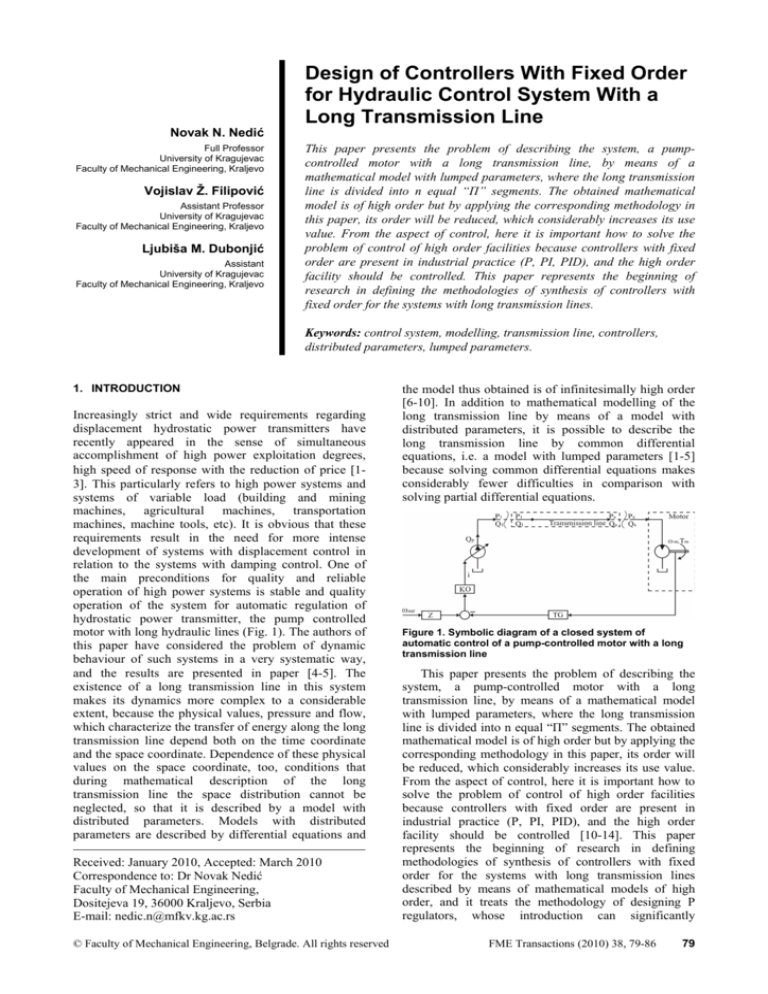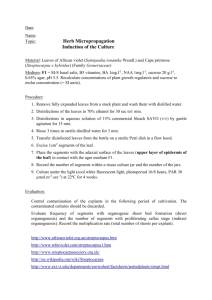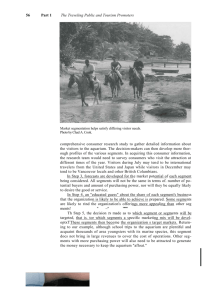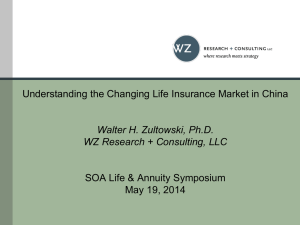
Novak N. Nedić
Full Professor
University of Kragujevac
Faculty of Mechanical Engineering, Kraljevo
Vojislav Ž. Filipović
Assistant Professor
University of Kragujevac
Faculty of Mechanical Engineering, Kraljevo
Ljubiša M. Dubonjić
Assistant
University of Kragujevac
Faculty of Mechanical Engineering, Kraljevo
Design of Controllers With Fixed Order
for Hydraulic Control System With a
Long Transmission Line
This paper presents the problem of describing the system, a pumpcontrolled motor with a long transmission line, by means of a
mathematical model with lumped parameters, where the long transmission
line is divided into n equal “П” segments. The obtained mathematical
model is of high order but by applying the corresponding methodology in
this paper, its order will be reduced, which considerably increases its use
value. From the aspect of control, here it is important how to solve the
problem of control of high order facilities because controllers with fixed
order are present in industrial practice (P, PI, PID), and the high order
facility should be controlled. This paper represents the beginning of
research in defining the methodologies of synthesis of controllers with
fixed order for the systems with long transmission lines.
Keywords: control system, modelling, transmission line, controllers,
distributed parameters, lumped parameters.
1. INTRODUCTION
Increasingly strict and wide requirements regarding
displacement hydrostatic power transmitters have
recently appeared in the sense of simultaneous
accomplishment of high power exploitation degrees,
high speed of response with the reduction of price [13]. This particularly refers to high power systems and
systems of variable load (building and mining
machines, agricultural machines, transportation
machines, machine tools, etc). It is obvious that these
requirements result in the need for more intense
development of systems with displacement control in
relation to the systems with damping control. One of
the main preconditions for quality and reliable
operation of high power systems is stable and quality
operation of the system for automatic regulation of
hydrostatic power transmitter, the pump controlled
motor with long hydraulic lines (Fig. 1). The authors of
this paper have considered the problem of dynamic
behaviour of such systems in a very systematic way,
and the results are presented in paper [4-5]. The
existence of a long transmission line in this system
makes its dynamics more complex to a considerable
extent, because the physical values, pressure and flow,
which characterize the transfer of energy along the long
transmission line depend both on the time coordinate
and the space coordinate. Dependence of these physical
values on the space coordinate, too, conditions that
during mathematical description of the long
transmission line the space distribution cannot be
neglected, so that it is described by a model with
distributed parameters. Models with distributed
parameters are described by differential equations and
Received: January 2010, Accepted: March 2010
Correspondence to: Dr Novak Nedić
Faculty of Mechanical Engineering,
Dositejeva 19, 36000 Kraljevo, Serbia
E-mail: nedic.n@mfkv.kg.ac.rs
© Faculty of Mechanical Engineering, Belgrade. All rights reserved
the model thus obtained is of infinitesimally high order
[6-10]. In addition to mathematical modelling of the
long transmission line by means of a model with
distributed parameters, it is possible to describe the
long transmission line by common differential
equations, i.e. a model with lumped parameters [1-5]
because solving common differential equations makes
considerably fewer difficulties in comparison with
solving partial differential equations.
Figure 1. Symbolic diagram of a closed system of
automatic control of a pump-controlled motor with a long
transmission line
This paper presents the problem of describing the
system, a pump-controlled motor with a long
transmission line, by means of a mathematical model
with lumped parameters, where the long transmission
line is divided into n equal “П” segments. The obtained
mathematical model is of high order but by applying the
corresponding methodology in this paper, its order will
be reduced, which considerably increases its use value.
From the aspect of control, here it is important how to
solve the problem of control of high order facilities
because controllers with fixed order are present in
industrial practice (P, PI, PID), and the high order
facility should be controlled [10-14]. This paper
represents the beginning of research in defining
methodologies of synthesis of controllers with fixed
order for the systems with long transmission lines
described by means of mathematical models of high
order, and it treats the methodology of designing P
regulators, whose introduction can significantly
FME Transactions (2010) 38, 79-86
79
influence the improvement of quality of dynamic
behaviour of these systems.
The mathematical model of the system is determined by
describing every element of SAR by fundamental
equations, with the corresponding assumptions. The
structure of a part of the system, on the basis of which
modelling is performed, is presented in Figure 2.
P
U
M
P
P1
Q1
Transmission
line
P2
Q2
M
O
T
O
R
(6)
V
1
; Cm = m .
B
Rm
The loads which should be overcome by the
hydromotor are: inertial, viscous, and external. The
moment equation of hydromotor load is given in the
following form:
where: Z m ( s ) = Cm s +
2. DYNAMIC MATHEMATICAL MODEL OF THE
SYSTEM OF A PUMP-CONTROLLED MOTOR
WITH A LONG TRNASMISSION LINE
ωp
Q2 ( s ) = Dmωm ( s ) + Z m p2 ( s )
ωm
Dm p2 (t ) = J m
dωm (t )
+ Bvωm (t ) + TL (t ) .
dt
By applying the Laplace Transform, Equation (7) at
all initial conditions equal to zero obtains the following
form:
Dm p2 ( s ) = J m sωm ( s ) + Bvωm ( s ) + TL ( s ) .
Figure 2. Structural diagrams of the subsystem [1]
(7)
(8)
By transforming (8), the following expression for
pressure at the end of the long transmission line is
obtained:
2.1 Pump
The pump is of variable working volume with the
constant number of revolutions. Leakage and
compressibility of oil in the pump are taken into
consideration through the coefficient of leakage
resistance Rp and the module of compressibility B. The
flow at the exit of the pump, Qp = Q1, is equal to the
flow at the beginning of the long transmission line and
is described by the equation:
Q1 (t ) = D p (t )ω p −
dp (t )
1
p1 (t ) − C p 1 .
Rp
dt
1
p1 ( s ) − C p sp1 ( s )
Rp
Q1 ( s ) = D p ( s )ω p − Z p p1 ( s )
where: Z p ( s ) = C p s +
(2)
(3)
2.2 Hydro-motor
The hydromotor is of constant working volume with a
variable number of revolutions. Leakage and
compressibility of oil in the motor are covered through
the characteristic coefficients Rm and Cm, respectively.
The flow at the exit of the long transmission line is
equal to the flow at the hydromotor Q2 = Qm and is
described by the equation:
dp (t )
1
p2 (t ) + Cm 2 .
Rm
dt
80 ▪ VOL. 38, No 2, 2010
s+
Bv
– the characteristic impedance
Dm2
of internal load at the hydromotor.
Dm2
The long transmission line represents the connection
between the pump and the hydromotor. As the length of
transmission lines ranges between several meters and
several dozen meters, it is clear that pressures and flows
at the beginning and at the end of the line are not equal,
so that its influence in such systems cannot be
neglected.
Figure 3 presents the symbolic scheme of a
transmission line modelled through a “П” approximate
model with lumped parameters. In this model, the initial
assumption is that the overall volume of the
transmission line V = A · l, is divided into two parts and
concentrated at its ends with the equivalent module of
compressibility E and the flow in the middle of the
transmission line Qe, so that this model is called “the
model of medium flow” in literature [1]. In other parts
of the long transmission line, the working fluid is
considered incompressible, and the line itself is
considered non-elastic.
(4)
By applying the Laplace Transform, Equation (4) at all
initial conditions equal to zero obtains the following form:
1
Q2 ( s ) = Dmωm ( s ) +
p2 ( s ) + Cm sp2 ( s )
Rm
Jm
(9)
2.3 Long transmission line
Vp
1
; Cp =
.
Rp
B
Q2 (t ) = Dmωm (t ) +
where: ZT =
TL ( s )
Dm
(1)
By applying the Laplace Transform, Equation (1) at
all initial conditions equal to zero obtains the following
form:
Q1 ( s ) = D p ( s )ω p −
p2 ( s ) = ZT Dmωm ( s ) +
(5)
Figure 3. Symbolic scheme of the transmission line
modelled by a “П” approximate model with lumped
parameters
This model can also be presented through its
equivalent electrical analogy in the form of a simple
electric circuit shown in Figure 4.
FME Transactions
Dmωm(s) =
Figure 4. Equivalent electrical analogy of the “П” scheme
of a transmission line with lumped parameters
By solving this electric circuit, the equations
connecting the pressures and flows at the beginning and
at the end of the long transmission line are obtained:
p1 ( s ) = (1 +
Q1 ( s ) = Y 1 (1 +
Z 1Y 1
) p2 ( s ) + Z 1Q2 ( s )
2
(10)
Z 1Y 1
Z 1Y 1
) p2 ( s ) + (1 +
)Q2 ( s ) (11)
4
2
where: Z1 – the equivalent impedance of the described
hydraulic circuit; Y1 – the equivalent admittance of the
described hydraulic circuit
128µ
πd
4
; L=
ρ
A
; C=
A
ρc
2
=
(12)
A
E
(13)
and represent the resistance, inductivity and capacity of
the transmission line, respectively (µ – the coefficient of
dynamic viscosity of the working fluid; d – the diameter
of the transmission line; ρ – the density of the working
fluid in the transmission line; A – the area of the crosssection of the transmission line; E – the equivalent
modulus of elasticity; c – the velocity of sound in the
fluid).
The transmission matrix for the “Π” model with
lumped parameters is given by the equation:
⎡
⎤
Z 1Y 1
(1 +
)
Z1
⎢
⎥ p
⎡ p1 ⎤ ⎢
2
⎥⋅⎡ 2⎤ .
⎢Q ⎥ = ⎢
1 1
1 1 ⎥ ⎢Q ⎥
⎣ 1⎦
⎣ 2⎦
ZY
ZY
⎢Y 1 (1 +
) (1 +
)⎥
⎣
4
2 ⎦
(14)
The equation describing the connections between the
flow and the pressure at the end and at the beginning of
the transmission line is given in the form of a
transmission matrix [15].
⎡ p1 ( s ) ⎤ ⎡ AL
⎢ Q ( s ) ⎥ = ⎢C
⎣ 1 ⎦ ⎣ L
BL ⎤ ⎡ p2 ( s ) ⎤
.
⋅
DL ⎥⎦ ⎢⎣Q2 ( s ) ⎥⎦
(15)
Equation (15) represents the general form of the
transmission matrix of the long transmission line with
lumped parameters. The values of parameters AL, BL, CL
and DL in (15) correspond to the values from (14).
By linking (15) with (3), (6) and (9) and on the basis
of the characteristics of the coefficients of the long
transmission line: AL = DL and ALDL – BLCL = 1, the
transmission function of a part of the system of
automatic regulation is obtained in the following form:
FME Transactions
)
m
(1+ZmZT +ZpZT ) AL +( Zp +ZpZmZT ) BL +ZTCL
. (16)
Equation (16) represents a mathematical model of a
part of the automatic control system, when the long
transmission line is modelled as a “П” segment with the
length l. However, since transmission lines can be
several dozen meters long, then observation of the long
transmission line as a “П” segment with the length l
would not cover the complete dynamics of the very
physical process taking place along the transmission
line. Therefore, the transmission line is divided into n
equal “П” segments with the length l/n for the purpose
of obtaining an adequate mathematical model of a long
transmission line and hence of a described system of
automatic regulation.
Figure 5. The transmission line divided into n segments of
equal length l/n
As:
Z 1 = R1 + L1s ; Y 1 = C1s ;
R = R ⋅l ; L = L ⋅l ; C = C ⋅l
R=
(
1
Dp(s)ωp −⎡ Zm +Zp AL +ZmZpBL +CL⎤ TL(s)
⎣
⎦D
⎡ p1 ( s ) ⎤ ⎡ AL
⎢ Q ( s ) ⎥ = ⎢C
⎣ 1 ⎦ ⎣ L
BL ⎤ ⎡ p2 ( s ) ⎤
;
⋅
DL ⎥⎦ ⎢⎣Q2 ( s ) ⎥⎦
⎡ p2 ( s ) ⎤ ⎡ AL BL ⎤ ⎡ p3 ( s ) ⎤
⎥;
⎢ Q ( s ) ⎥ = ⎢C
⎥⋅⎢
⎣ 2 ⎦ ⎣ L DL ⎦ ⎣Q3 ( s ) ⎦
⎡ pn −1 ( s ) ⎤ ⎡ AL BL ⎤ ⎡ pn ( s ) ⎤
⎢
⎥=⎢
⎥.
⎥⋅⎢
⎣Qn −1 ( s ) ⎦ ⎣CL DL ⎦ ⎣Qn ( s ) ⎦
(17)
Linking of these equations results in:
⎡ p1 ( s ) ⎤ ⎡ AL
⎢ Q ( s ) ⎥ = ⎢C
⎣ 1 ⎦ ⎣ L
n
BL ⎤ ⎡ pn ( s ) ⎤
.
⋅
DL ⎥⎦ ⎢⎣Qn ( s ) ⎥⎦
(18)
Now, the basic elements of the long transmission
line figuring in the polynomials AL, BL, CL and DL have
the values:
R1 = R ⋅
l
l
l
; L1 = L ⋅ ; C1 = C ⋅ .
n
n
n
(19)
By using the program package Matlab, a program
linking (18) with (3), (6) and (9) is written, so that a
mathematical model of the described system is obtained
in the form of the transmission function W1(s) of a part
of the automatic control system for the finite number n
of equal “П” segments with the length l/n.
3. DYNAMIC BEHAVIOUR OF THE SYSTEM
CONTROLLED BY A “P” REGULATOR
The simulation of dynamic behaviour was performed in
the program package Matlab on the basis of the block
diagram of the described system presented in Figure 6.
The transmission function of the open circuit on the
block diagram has the following form:
Wok = K a KTG
ωp
Dm
W1 ( s ) = K ok W1 ( s )
(20)
VOL. 38, No 2, 2010 ▪ 81
where:
K ok = K a KTG
W1(s) =
ωp
Dm
1
(1+ ZmZT + ZpZT ) AL +( Zp + ZpZmZT ) BL + ZTCL
. (21)
The parameters at which the simulation was
performed: E = 1.44 · 109 N/m2; ρ = 860 kg/m3; µ =
0.033 Ns/m2; Rp = Rm = 1 · 1010 Nm-2/m3s-1; Qref = 2.5 ·
10-4 m3/s; d = 10 · 10-3 m; l = 16 m; c = 1290 m/s; Dm =
2.61 · 10-6 m3/rad; Bν = 1 · 10-3 Nms; Im = 6.9 · 10-3
kgm2; B = Bp = Bm = 1.2 · 109 N/m2; KTG = 1 · 10-2
V/rad/s.
Figure 6. Block diagram of the system
Figure 7 presents the hodograph of the frequent
characteristic of the open circuit in the 16-meter
transmission line divided into 16 equal segments! To
determine the stability limit, the Nyquist and Bode
criterion was used (Fig. 8) on the basis of which the
value Kok, for which the system is marginally stable,
was determined. Figure 8 also presents the Bode
diagrams when the line is divided into 4 equal segments,
on the basis of which it can be seen that up to certain
frequencies there are no significant deviations between
the models of the line divided into 16 and 4 equal
segments. The gain limit OK remains the same even
when the dynamics of the long transmission line is
covered by its division into 4 equal segments.
Nyquist Diagram
15
10
Imaginary Axis
5
0
-5
-10
-15
-5
0
5
10
15
20
25
Real Axis
Figure 7. Phase-frequent characteristic OK at n = 16, l = 16
m, Kok = 30.3
Figure 9 presents the system response to the unit
step change of input. The comparative presentation of
the system responses for different divisions of the long
transmission line with the length l = 16 m into equal
segments is shown. If n = 0, then the dynamics of the
line, although the line physically exists, is not covered
by the mathematical model. At n = 1, the transmission
line with the length of 16 m is observed as a “П”
segment, and its dynamics is now covered by the
mathematical model of the system. Figure 9 also
presents the system responses at n = 4 and n = 16
segments. As with the frequency criterion, in the time
82 ▪ VOL. 38, No 2, 2010
domain it was shown that deviations in the response in
the division of the transmission line into 16 and 4 equal
segments is small and can be neglected. Every division
of the transmission line into more than 4 segments gives
slightly better results from the aspect of the system
response. Divisions of the transmission line into up to 3
segments allow considerable deviations in the response
and must not be neglected, before all, from the aspect of
system stability.
This imposes the conclusion that the dynamics of the
transmission line in the mathematical model of the
described system is best presented by the division of the
transmission line into 4 segments of the same length.
Division into 4 segments does not disturb the stability
limit, deviations in the response are small, and the order
of the described system is considerably reduced. For the
line division into 16 segments, the system is of the 34th
order, while for the one with 4 segments, it is of the 10th
order.
Figure 10 presents the system response in the
division of the line into 16 equal segments with
different lengths of l = 0, 4, 8 and 16 for the boundary
gain value of the open circuit Kok = 30.3. On the basis of
the results of simulation shown in Figure 10, it is seen
that at smaller lengths of the transmission line, its
dynamics has a considerably smaller influence on the
behaviour of the whole automatic control system.
On the basis of the results of simulation in the
frequency and time domains of the described automatic
control system controlled by a P regulator, the optimum
number of segments in which the transmission line is l =
16 m long should be divided is determined, and its
dynamics in the overall mathematical model of the
system could thus be adequately covered. It was
established that in the division of the transmission line
of this length, its division into 4 equal segments gives
satisfactory results from the aspect of stability and
response of the described system, and the order of the
system is considerably reduced. Figure 11 presents the
system response in the division of the transmission line
with the length of 16 m into 4 equal segments for three
values of the gain factor of the open circuit Kok = 30.3
when the system is marginally stable, Kok = 20.3 and Kok
= 15 from the range of stable operation of the system.
From these diagrams, it is clearly seen that the reduction
of gain of the P regulator influences the reduction of
step from 111 to 29.9 %. Further reduction of gain
would considerably contribute to the reduction of step,
but it would have negative influence on the error and the
speed of response of the described system.
4. APPLICATION OF CONTROLLERS WITH TWO
DEGREES OF FREEDOM
As the problem of step occurring in these systems cannot
be efficiently solved by a classical P regulator without
disturbing the speed of response and the static error of
the regulated value, a regulator proposed by Horowitz
[12], which enables the correct following of the given
desired reference, is introduced. By introducing the
additional regulator whose transmission function is
WR(s), the described system is controlled by a regulator
with two degrees of freedom because it has, in addition
FME Transactions
Bode Diagram
Gm = 0.0282 dB (at 131 rad/sec) , Pm = 0.313 deg (at 130 rad/sec)
500
n=4
Magnitude (dB)
0
-500
n = 16
-1000
-1500
0
n=4
Phase (deg)
-720
-1440
-2160
n = 16
-2880
-3600
-1
10
0
10
1
10
10
2
10
3
4
5
10
10
Frequency (rad/sec)
Figure 8. Logarithm frequency characteristic OK at n = 16, n = 4 and l = 16 m Kok = 30.3
Step Response
250
n = 16
n=4
200
Amplitude
150
100
50
n=1
0
n=0
-50
0
0.05
0.1
0.15
0.2
0.25
0.3
Time (sec)
Figure 9. The system response in the line division into n = 0, 1, 4 and 16 segments at the transmission line length l = 16 m
FME Transactions
VOL. 38, No 2, 2010 ▪ 83
Step Response
250
200
Amplitude
150
100
l=8m
50
l=4m
0
l=0m
-50
0
0.02
l = 16 m
0.04
0.06
0.08
0.1
0.12
0.14
0.16
0.18
0.2
Time (sec)
Figure 10. The system response in the line division into n = 16 segments at the transmission line length l = 0, 4, 8 and 16 m
and the gain value Kok = 30.3
Step Response
250
System: Ws
Peak amplitude: 202
Overshoot (%): 111
At time (sec): 0.0319
200
System: Ws
Peak amplitude: 149
Overshoot (%): 58.3
AtSystem:
time (sec):
Ws 0.0348
Amplitude
150
Peak amplitude: 120
Overshoot (%): 29.9
At time (sec): 0.0395
100
50
0
-50
0
0.05
0.1
0.15
0.2
0.25
0.3
Time (sec)
Figure 11. The system response in the line division into n = 4 segments at the transmission line length l = 16 m, for the gain
value Kok = 30.3, 20.3 and 15
84 ▪ VOL. 38, No 2, 2010
FME Transactions
to the classical P regulator, another regulator according
to the given desired reference (Fig. 12). The transmission
function of the regulator according to the reference Vd(s)
has the form WR(s) = (τ1s + 1)/(τ2s + 1). By selecting the
time constants τ1 = 0.03 s and τ2 = 0.05 s, where it is
obvious that τ2 > τ1, which would reduce the speed of
response of the system. Simulation in the program
package Matlab in Figure 13 presents a comparative
diagram of the system responses when it is controlled by
the classical P regulator and the regulator with two
degrees of freedom. From Figure 13 it can be seen that
System: Ws
Peak amplitude: 149
Overshoot (%): 58.3
At time (sec): 0.0348
we succeeded in reducing the step from 58.3 to 10.3 %
with a slight reduction of speed of response by about 2
ms, by using the regulator with two degrees of freedom
for control of the system described in Figure 12.
Figure 12. Block diagram of the system controlled by the
regulator with two degrees of freedom
Step Response
150
System: Wss
Peak amplitude: 104
Overshoot (%): 10.3
At time (sec): 0.0368
Amplitude
100
50
0
0
0.05
0.1
0.15
0.2
0.25
0.3
Time (sec)
Figure 13. Comparative response of the system in the division of the line into n = 4 segments at the length of the transmission
line of l = 16m, controlled by a P regulator and the regulator with two degrees of freedom
5. CONCLUSION
On the basis of the analysis in the frequency and time
domains of a transmission system with a long
transmission line, it can be concluded as follows:
• That it is possible to reduce the high order of the
described system several times by adequate
selection of division of the long transmission line
into the optimum number of segments;
• That the reduction of the length of the
transmission line, when possible, can reduce the
influence of dynamics of the transmission line on
FME Transactions
•
•
the dynamics of the whole system. The influence
of dynamics of the transmission line on the
behaviour of the whole system increases with the
increase of its length;
That selection of the corresponding gain of the
P regulator can considerably influence the
reduction of step, and hence the increase of
error and reduction of speed of the system
response;
That control of the described system by means of
a regulator with two degrees of freedom can
solve the problem of step, with a slight reduction
of the speed of response;
VOL. 38, No 2, 2010 ▪ 85
•
That design of appropriate controllers with fixed
order can considerably influence the quality of
dynamic behaviour of these systems and
improvement of their performance.
REFERENCES
[1] Watton, J.: Fluid Power Systems, Prentice Hall,
Upper Saddle River, 1989.
[2] Watton, J.: The dynamic performance of an
electrohydraulic servovalve/motor system with
transmission line effects, ASME Journal Dynamic
Systems, Measurement and Control, Vol. 109, No.
1, pp. 14-18, 1987.
[3] Watton, J. and Tadmori, M.J.: A comparison of
techniques for the analysis of transmission line
dynamics in electrohydraulic control systems,
Applied Mathematical Modelling, Vol. 12, No. 5,
pp. 457-466, 1988.
[4] Nedić, N.N., Petrović, R. and Dubonjić, Lj.M.:
Dynamic behavior of servo controlled hydrostatic
power transmission system with long transmission
line, in: Proceedings of the International
Conference – Mechanization, Electrification and
Automation in Mines, 14-17.05.2003, Sofia,
Bulgaria, pp. 267-271.
[5] Nedić, N.N. and Dubonjić, Lj.M.: The stability and
response of the electrohydraulic valve controlled
hydromotor with long transmission flow line, in:
Proceedings of the VIII International SAUM
Conference, 05-06.11.2004, Belgrade, Serbia, pp.
186-193.
[6] Stecki, J.S. and Davis, D.C.: Fluid transmission
lines – distributed parameter models. Part 1: A
review of the state of the art, Proceedings of the
Institution of Mechanical Engineers. Part A:
Journal of Power and Energy, Vol. 200, No. 4, pp.
215-228, 1986.
[7] Stecki, J.S. and Davis, D.C.: Fluid transmission
lines – distributed parameter models. Part 2:
Comparison of models, Proceedings of the
Institution of Mechanical Engineers. Part A:
Journal of Power and Energy, Vol. 200, No. 4, pp.
229-236, 1986.
[8] Hullender, D.A. and Healey, A.J.: Rational
polynomial approximations for fluid transmission
line models, in: Proceedings of the ASME Winter
Annual Meeting – Fluid Transmission Line
Dynamics, 15-20.11.1981, Washington, USA, pp.
33-55.
[9] Hsue, C.Y.-Y. and Hullender, D.A.: Modal
approximations for the fluid dynamics of hydraulic
and pneumatic transmission lines, in: Proceedings
of the ASME Winter Annual Meeting – Fluid
Transmission Line Dynamics, 13-18.11.1983,
Boston, USA, pp. 51-77.
86 ▪ VOL. 38, No 2, 2010
[10] Hullender, D.A., Woods, R.L. and Hsu, C.-H.:
Time domain simulation of fluid transmission lines
using minimum order state variable models, in:
Proceedings of the ASME Winter Annual Meeting –
Fluid Transmission Line Dynamics, 13-18.11.1983,
Boston, USA, pp. 78-97.
[11] Ho, M.-T., Datta, A. and Bhattachary, S.P.: Control
system design using low order controllers: Constant
gain, PI and PID, in: Proceedings of the 1997
American Control Conference, 04-06.06.1997,
Albuquerque, USA, pp. 571-578.
[12] Horowitz, I.M.: Synthesis of Feedback Systems,
Academic Press, New York, 1963.
[13] Åström, K.J. and Hägglund, T.: Advanced PID
Control, ISA – International Society of
Automation, Research Triangle Park, 2006.
[14] Filipović, V.Ž. and Nedić, N.N.: PID Regulators,
Faculty of Mechanical Engineering Kraljevo,
University of Kragujevac, Kraljevo, 2008, (in
Serbian).
[15] Dubonjić, Lj.M.: Dynamical Analysis of
Electrohydraulic Control Systems with Long
Transmission Line, MSc thesis, Faculty of
Mechanical Engineering, University of Kragujevac,
Kraljevo, 2002, (in Serbian).
ПРОЈЕКТОВАЊЕ РЕГУЛАТОРА ФИКСНЕ
СТРУКТУРЕ ЗА ХИДРАУЛИЧНЕ СИСТЕМЕ
УПРАВЉАЊА СА ДУГАЧКИМ ВОДОВИМА
Новак Н. Недић, Војислав Ж. Филиповић,
Љубиша М. Дубоњић
У овом раду је изложена проблематика система
пумпно
управљаног
мотора
са
дугачким
хидрауличним водовима, математичким моделом са
концентрисаним параметрима где је дугачки
хидраулични вод подељен на n једнаких „П“
сегмената. Тако добијен математички модел је
вишег
реда,
али
применом
одговарајуће
методологије, његов ред ће бити редукован и тиме
знатно повећана његова употребна вредност. Са
аспекта управљања, овде се појављује проблем, како
решити проблем управљања објекта вишег реда, јер
су у индустријској пракси присутни само регулатори
фиксне структуре (П, ПИ, ПИД) а треба управљати
објектом вишег реда. Овај рад представља почетак
истраживања у циљу дефинисања методологије
синтезе
регулатора
фиксне
структуре
за
хидрауличне системе са дугачким водовима који су
описни математичким моделима вишег реда, такође,
у њему је обрађена и методологија пројектовања П
регулатора чијим се увођењем у знатној мери може
утицати на побољшање квалитета динамичког
понашања ових система.
FME Transactions








